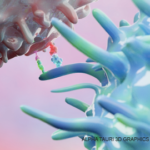The body uses B cells to produce antibodies that can fight off infection by invading antigens and bacteria. But in rheumatoid arthritis (RA), the immune system produces autoantibodies that work against the body’s proteins to attack joint tissues. Researchers believe this process is helped along by autoreactive B cells that live in bone matter and release proinflammatory cytokines.
As part of a new study, researchers used ribonucleic acid (RNA) sequencing to obtain a comprehensive transcriptome profile of human citrulline-specific B cells in patients with RA.1
The researchers investigated relationships between interleukin (IL) 15α and citrulline-specific B cells. They also studied the capability of B cells from RA patients to produce amphiregulin, a protein that is part of the epidermal growth factor (EGF) family and that stimulates differentiation and growth of cells. The findings, published in the journal Arthritis & Rheumatology, indicate the potential role B cells play in increased differentiation of cells responsible for eroding bone.
“Our results portray B cells as not merely autoantibody producers, but as a source of diverse molecules that can influence proliferation, differentiation and activation of other pathogenic cells types,” wrote Ankit Mahendra, PhD, the study’s lead author and a scientist employed by Sanofi. At the time of the study’s publication, he was a postdoctoral fellow at the University of Houston’s Department of Chemical and Biomolecular Engineering.
The Methods
In this study, the researchers investigated “if there are fundamental differences in the biology of the B cells themselves,” says senior author Navin Varadarajan, PhD, associate professor of chemical and biomolecular engineering at the University of Houston.
The research team compared three groups of cell types: autoreactive anti-cyclic citrullinated peptide (CCP) and rheumatoid factor positive (RA-CCPpos) B cells from RA patients; RA-CCP negative (RA-CCPneg) B cells from RA patients that were not autoreactive; and B cells from healthy donors who produced antibodies against influenza (hemagglutinin-specific/HA) after vaccination.
“We wanted to take an unbiased discovery approach to see what’s different about the biology of these B cells compared [with] B cells from healthy donors,” Dr. Varadarajan says. “We used RNA sequencing to understand differences in basic B cell biology between these different groups.”
Hemagglutinin is a surface protein from influenza the researchers used to identify B cells likely to be reactive to influenza. Similarly, “autoantibodies in rheumatoid arthritis are reactive to citrullinated peptides,” says Dr. Varadarajan. “So you are using the citrullinated peptides to identify B cells that are autoreactive.”
Researchers isolated citrulline- and hemagglutinin-specific B cells using peptide-streptavidin conjugates from peripheral blood of RA patients and healthy controls. With messenger RNA (mRNA) serving as a surrogate for protein expression, the researchers conducted RNA sequencing of the sorted cells to obtain a transcriptome profile.
Key protein molecules were evaluated with aptamer-based proteomic assays and flow cytometry. In vitro functional assays were employed to study how the proteins affect differentiation of osteoclasts and proliferation and migration of synoviocytes, cells inside the synovium that are considered a hallmark of RA pathogenesis.


